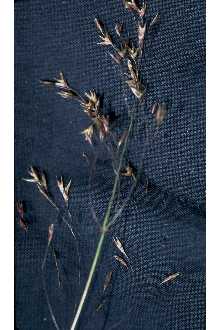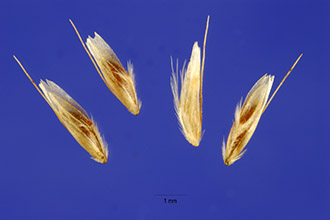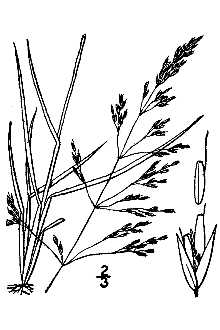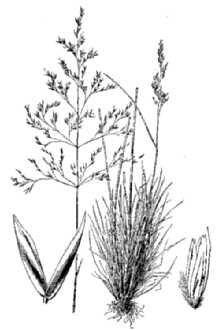Aira caespitosa L.
Scientific Name: Aira caespitosa L.

| General Information | |
|---|---|
| Usda Symbol | AICA6 |
| Group | Monocot |
| Life Cycle | Perennial |
| Growth Habits | Graminoid |
| Native Locations | AICA6 |
Plant Guide
Use soil moisture sensors to measure the soil moisture of Aira caespitosa L..
Fact Sheet
Uses
Tufted hairgrass is useful for restoring moist to seasonally wet prairies and stabilizing disturbed sites, streambanks, canals, shorelines, and upper tidal marshes. Other applications include acid and heavy metal mine spoil reclamation, alpine and boreal revegetation work, and bio-filtration swales. As a range or pasture grass, it is both a desirable, productive forage for cattle and sheep particularly at higher elevations, and a species of lesser or low value in regions where plants are coarse and less palatable. The species is sometimes cut for hay. Utilization by deer, elk, pronghorn, bison, bear, horses, and rabbits is variable. Likewise, cover and food values are rated poor to good for small mammals, upland game birds, songbirds, and waterfowl depending on wildlife species and location. Tufted hairgrass is a larval food plant for several butterflies in North America and is host for at least 40 species of Lepidopteran insects world-wide. Varieties have been bred as wear resistant turf for golf courses, sports fields and other uses.
Description
Tufted hairgrass is a highly variable, perennial cool season species that grows 20 to 60 in. tall. Stems are erect and the leaves are .06 to .16 in. wide, flat or rolled, and mostly basal in a dense tuft. The panicle (seed head or inflorescence) is upright to nodding, loosely branched, open, and 4 to 10 in. long. There are two florets (flowers) per spikelet. Flowering occurs from May to September and seeds mature from late June to late September depending on location.
Status
Please consult the Plants Web site and your State Department of Natural Resources for this plant’s current status, such as state noxious and wetland indicator values, , Use soil moisture sensors to measure the soil moisture of Aira caespitosa L..
Adaptation
Populations occupy moderately moist to seasonally flooded, sunny to partially shaded environments with a wide variety of soil types (fine to coarse, mesic to hydric) and pH ranging from 3.5 to 7.5. Some populations have extreme tolerance to heavy metals and high soil acidity. Salinity tolerance is generally considered low, but plants occurring in coastal estuaries may be slightly more salt tolerant. Crowns typically survive all but the most severe or hottest fires. Distribution-As one of the most widely distributed grasses on earth, tufted hairgrass is found in many arctic and temperate regions. It occurs from sea level to 14,000 ft in the mountains. Habitats include coastal terraces, upper tidal marshes, seasonally wet prairies, moist subalpine mountain meadows, open forests, and alpine areas above timberline. Limitations or environmental concerns Tufted hairgrass is host to a number of diseases including ergot, several rusts, stripe smut, blind seed, several leaf spots, and the turf disease take all patch. Insect pests typical of pasture and turf grasses include aphids, billbugs, leafhoppers, and others. In some parts of the world, this grass spreads readily into newly disturbed areas, is a weed in certain forage crops, and can become a serious competitor with trees. Reprinted with permission Univ. of WA Press Specific management practices are applied to wet, low elevation pastures in Europe in order to control it. The plant is considered nontoxic to livestock and humans. Uses such as general cover and turf can be limited by summer moistustress and billbugs.
Plant Traits
Growth Requirements
| CaCO3 Tolerance | Medium |
|---|---|
| Frost Free Days, Minimum | 80 |
| Frost Free Days, Minimum | 100 |
| Frost Free Days, Minimum | 100 |
| Fire Tolerance | High |
| Fire Tolerance | High |
| Fire Tolerance | High |
| Fertility Requirement | Medium |
| Fertility Requirement | Medium |
| Fertility Requirement | Medium |
| Drought Tolerance | Low |
| Drought Tolerance | Low |
| Drought Tolerance | High |
| Cold Stratification Required | No |
| Cold Stratification Required | No |
| Cold Stratification Required | No |
| Temperature, Minimum (°F) | -43 |
| CaCO3 Tolerance | Low |
| CaCO3 Tolerance | Low |
| Anaerobic Tolerance | Low |
| Anaerobic Tolerance | High |
| Anaerobic Tolerance | High |
| Adapted to Medium Textured Soils | Yes |
| Adapted to Medium Textured Soils | Yes |
| Adapted to Medium Textured Soils | Yes |
| Adapted to Fine Textured Soils | Yes |
| Adapted to Fine Textured Soils | Yes |
| Adapted to Fine Textured Soils | No |
| Adapted to Coarse Textured Soils | Yes |
| Adapted to Coarse Textured Soils | Yes |
| Adapted to Coarse Textured Soils | No |
| Hedge Tolerance | None |
| Temperature, Minimum (°F) | -38 |
| Temperature, Minimum (°F) | -38 |
| Shade Tolerance | Intolerant |
| Shade Tolerance | Intolerant |
| Shade Tolerance | Intolerant |
| Salinity Tolerance | None |
| Salinity Tolerance | Low |
| Salinity Tolerance | Low |
| Root Depth, Minimum (inches) | 8 |
| Root Depth, Minimum (inches) | 14 |
| Root Depth, Minimum (inches) | 14 |
| Precipitation, Minimum | 14 |
| Precipitation, Minimum | 14 |
| Precipitation, Minimum | 10 |
| Precipitation, Maximum | 24 |
| Hedge Tolerance | None |
| Hedge Tolerance | None |
| Moisture Use | High |
| Moisture Use | Low |
| Moisture Use | Low |
| pH, Maximum | 7.2 |
| pH, Maximum | 7.2 |
| pH, Maximum | 7.5 |
| pH, Minimum | 4.8 |
| pH, Minimum | 4.8 |
| pH, Minimum | 5.5 |
| Precipitation, Maximum | 24 |
| Precipitation, Maximum | 60 |
Morphology/Physiology
| Active Growth Period | Spring and Summer |
|---|---|
| Toxicity | None |
| Toxicity | None |
| Toxicity | None |
| Shape and Orientation | Semi-Erect |
| Shape and Orientation | Erect |
| Shape and Orientation | Erect |
| Resprout Ability | No |
| Resprout Ability | No |
| Flower Conspicuous | No |
| Fall Conspicuous | No |
| Fire Resistant | No |
| Fire Resistant | No |
| Fire Resistant | No |
| Flower Color | Yellow |
| Flower Color | Yellow |
| Flower Color | Yellow |
| Flower Conspicuous | No |
| Fall Conspicuous | No |
| Flower Conspicuous | No |
| Foliage Color | Green |
| Foliage Color | Green |
| Foliage Color | Green |
| Foliage Porosity Summer | Moderate |
| Foliage Porosity Summer | Moderate |
| Foliage Porosity Summer | Porous |
| Foliage Porosity Winter | Porous |
| Bloat | None |
| Resprout Ability | No |
| Active Growth Period | Spring and Summer |
| Active Growth Period | Summer and Fall |
| After Harvest Regrowth Rate | Moderate |
| After Harvest Regrowth Rate | Rapid |
| After Harvest Regrowth Rate | Slow |
| Bloat | None |
| Bloat | None |
| Nitrogen Fixation | None |
| C:N Ratio | Medium |
| C:N Ratio | Medium |
| C:N Ratio | Medium |
| Coppice Potential | No |
| Coppice Potential | No |
| Coppice Potential | No |
| Fall Conspicuous | No |
| Lifespan | Long |
| Height, Mature (feet) | 3.4 |
| Height, Mature (feet) | 3.4 |
| Known Allelopath | No |
| Known Allelopath | No |
| Known Allelopath | No |
| Leaf Retention | No |
| Leaf Retention | No |
| Leaf Retention | No |
| Foliage Porosity Winter | Porous |
| Lifespan | Long |
| Lifespan | Moderate |
| Low Growing Grass | No |
| Low Growing Grass | No |
| Low Growing Grass | No |
| Nitrogen Fixation | None |
| Nitrogen Fixation | None |
| Growth Rate | Moderate |
| Height, Mature (feet) | 3.0 |
| Foliage Porosity Winter | Porous |
| Foliage Texture | Coarse |
| Foliage Texture | Fine |
| Foliage Texture | Medium |
| Fruit/Seed Color | Brown |
| Fruit/Seed Color | Brown |
| Fruit/Seed Color | Brown |
| Fruit/Seed Conspicuous | No |
| Fruit/Seed Conspicuous | No |
| Growth Form | Bunch |
| Growth Form | Bunch |
| Growth Form | Bunch |
| Growth Rate | Moderate |
| Growth Rate | Moderate |
| Fruit/Seed Conspicuous | No |
Reproduction
| Fruit/Seed Persistence | No |
|---|---|
| Propagated by Tubers | No |
| Propagated by Tubers | No |
| Propagated by Tubers | No |
| Propagated by Sprigs | No |
| Propagated by Sprigs | No |
| Propagated by Sprigs | No |
| Propagated by Sod | No |
| Propagated by Sod | No |
| Propagated by Sod | No |
| Propagated by Seed | Yes |
| Propagated by Seed | Yes |
| Propagated by Seed | Yes |
| Propagated by Cuttings | No |
| Propagated by Cuttings | No |
| Seed per Pound | 1300000 |
| Seed per Pound | 1308333 |
| Seed per Pound | 1500000 |
| Seed Spread Rate | Slow |
| Seed Spread Rate | Slow |
| Seed Spread Rate | Slow |
| Seedling Vigor | Low |
| Seedling Vigor | Medium |
| Seedling Vigor | Medium |
| Small Grain | No |
| Small Grain | No |
| Small Grain | No |
| Vegetative Spread Rate | None |
| Vegetative Spread Rate | None |
| Vegetative Spread Rate | None |
| Propagated by Corm | No |
| Propagated by Cuttings | No |
| Bloom Period | Late Summer |
| Bloom Period | Mid Spring |
| Bloom Period | Mid Summer |
| Commercial Availability | Routinely Available |
| Commercial Availability | Routinely Available |
| Commercial Availability | Routinely Available |
| Fruit/Seed Abundance | High |
| Fruit/Seed Abundance | High |
| Fruit/Seed Abundance | Low |
| Fruit/Seed Period Begin | Spring |
| Fruit/Seed Period Begin | Summer |
| Fruit/Seed Period Begin | Summer |
| Fruit/Seed Period End | Fall |
| Fruit/Seed Period End | Fall |
| Fruit/Seed Persistence | No |
| Fruit/Seed Period End | Summer |
| Propagated by Corm | No |
| Propagated by Corm | No |
| Propagated by Container | No |
| Propagated by Container | No |
| Propagated by Container | No |
| Propagated by Bulb | No |
| Propagated by Bulb | No |
| Propagated by Bulb | No |
| Propagated by Bare Root | No |
| Propagated by Bare Root | No |
| Propagated by Bare Root | No |
| Fruit/Seed Persistence | No |
Suitability/Use
| Palatable Browse Animal | Low |
|---|---|
| Palatable Graze Animal | Low |
| Palatable Graze Animal | Low |
| Palatable Graze Animal | Low |
| Palatable Human | No |
| Palatable Human | No |
| Palatable Human | No |
| Post Product | No |
| Post Product | No |
| Post Product | No |
| Protein Potential | Low |
| Protein Potential | Low |
| Protein Potential | Low |
| Pulpwood Product | No |
| Pulpwood Product | No |
| Pulpwood Product | No |
| Veneer Product | No |
| Veneer Product | No |
| Veneer Product | No |
| Lumber Product | No |
| Berry/Nut/Seed Product | No |
| Berry/Nut/Seed Product | No |
| Berry/Nut/Seed Product | No |
| Christmas Tree Product | No |
| Christmas Tree Product | No |
| Christmas Tree Product | No |
| Fodder Product | No |
| Fodder Product | No |
| Fodder Product | Yes |
| Palatable Browse Animal | Low |
| Lumber Product | No |
| Lumber Product | No |
| Naval Store Product | No |
| Naval Store Product | No |
| Naval Store Product | No |
| Nursery Stock Product | No |
| Nursery Stock Product | No |
| Nursery Stock Product | No |
| Palatable Browse Animal | Low |



